
Imagine that you are the captain of a new vessel specially built to explore the interior of the Sun. We call interior the part of the Sun which is below its surface and therefore is not directly visible to us. There you are, at the commands of your vessel, on the visible surface of the Sun, which is also called the photosphere. You switch the motors on, point the nose of your vessel toward the center of the Sun and begin your trip. Immediately, you feel that the whole vessel is being shacked continuously. You are in the convection zone. The vibrations you feel are due to the fact that the fluid (we call it plasma) which is around your vessel is in a very turbulent state. It feels as if your vessel had dived into a gigantic pot of boiling water. The temperature at the surface was about 5,700° C but it is increasing as you go deeper and you realize that your vessel will soon begin to melt. Your on board computers calculate that by the time you will reach the bottom of the convection zone, at a depth of about 200,000 km, the temperature will be 2,000,000° C. Way too much for the vessel. You decide that this is definitely too dangerous for your crew and order to go back to the surface.
It would be nice to be able to see the Sun in situ. Unfortunately, this is impossible. Instead, scientists are using telescopes, satellites and computers to study the interior of the Sun. In the following we explain what we have discovered in this way about the convection zone.
Imaginary trip
Convection zone: where, what, how, why, ...
1. Where is the Convection Zone Located
2. What do we see from it
3. What is it
It is made out of plasma
It is convecting (boiling)
It is turbulent
It is rotating
It generates magnetic fields
It transports
magnetic fields
Why using computers to study the convection zone
1. Challenge
2. Virtual worlds
3. Logical procedure
4. One example: granulation
Learn more about some particular topics
Who studies the convection zone today
The interior of the Sun can be divided into three regions, depending on the kind of transport of energy which is in action: the core, the radiative zone and the convection zone:
 |
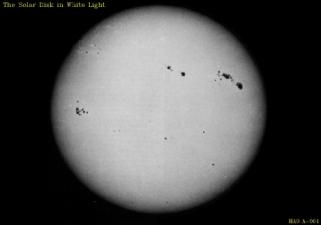 |
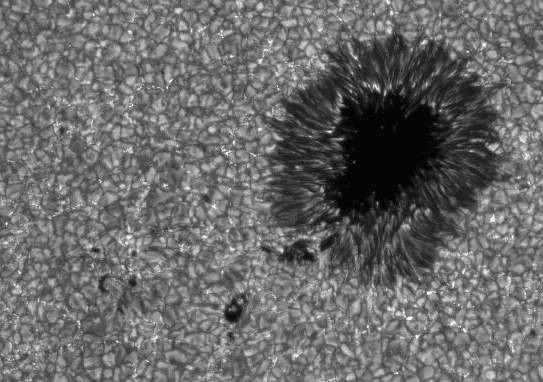 The result looks like this. This picture has been taken by
T. Berger
using the
Swedish
solar telescope located on the top of an island called
La Palma (one of the
Canary Islands off of
northwestern Africa).
The result looks like this. This picture has been taken by
T. Berger
using the
Swedish
solar telescope located on the top of an island called
La Palma (one of the
Canary Islands off of
northwestern Africa).
In this picture, white regions are hot and dark regions are cold.
Several interesting features are visible:
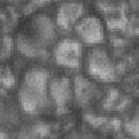 The whole
surface is covered with cells. They look very much like the cells you
can see at the surface of a pot of boiling water. We call them
convection cells because they are due to
convection, the
physical mechanisms responsible for the boiling water. The bright
regions correspond to hot rising material, whereas the dark lanes are
the location where the colder material falls down into the Sun. Click
on the image on the right to see an animation of these
convection cells as seen with the
Dutch Open
Telescope located on the Spanish island of
La Palma.
The whole
surface is covered with cells. They look very much like the cells you
can see at the surface of a pot of boiling water. We call them
convection cells because they are due to
convection, the
physical mechanisms responsible for the boiling water. The bright
regions correspond to hot rising material, whereas the dark lanes are
the location where the colder material falls down into the Sun. Click
on the image on the right to see an animation of these
convection cells as seen with the
Dutch Open
Telescope located on the Spanish island of
La Palma.
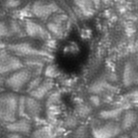 In addition
to the convection cells there are also these dark patches which are
visible on the surface. The big ones like in the picture above are
called sunspots and their diameter can be as big as the
diameter of the earth. The small ones, like in the side picture, are called
pores. Both indicate locations where concentrated
magnetic fields (imagine bundles of rubber bands) are
intersecting the surface of the Sun (How do we
know that there is a lot of magnetic field in the
sunspots?). Sunspots and pores are very dynamical features. Some
times they are no sunspots on the surface, some times there are a lot
of them. They are the manifestation of processes which take place in
the interior where we cannot look directly.
In addition
to the convection cells there are also these dark patches which are
visible on the surface. The big ones like in the picture above are
called sunspots and their diameter can be as big as the
diameter of the earth. The small ones, like in the side picture, are called
pores. Both indicate locations where concentrated
magnetic fields (imagine bundles of rubber bands) are
intersecting the surface of the Sun (How do we
know that there is a lot of magnetic field in the
sunspots?). Sunspots and pores are very dynamical features. Some
times they are no sunspots on the surface, some times there are a lot
of them. They are the manifestation of processes which take place in
the interior where we cannot look directly.
Understanding what is going on in the convection zone by looking only at the surface is a very complicated task. Scientists have found two ways of doing this:
It is made out of plasma. The convective zone, like the rest of the Sun, is made up entirely of plasma. A plasma is a 'gas' that conducts electrical currents, just like a wire does. The 'gas' contained in neon light bulbs is a plasma for example. The plasma in the convective zone is mainly made up of hydrogen (70% by mass), helium (27.7% by mass) plus small quantities of carbon, nitrogen and oxygen.
It is convecting (boiling). As we have seen above, the bottom of the convection zone is heated by the radiations coming out of the radiative zone, a bit like a room is heated by a radiator. The temperature at the bottom of the convection zone is 200,000° C. At the same time the top of the convection zone (surface of the Sun) is being cooled by the creation of light. The temperature at the surface is only about 5700° C. Thus, there exist a large temperature difference between the base and the surface of the convection zone.
This difference in the temperature results in a physical phenomenon called convection, which you are familiar with since you surely have seen a pot of boiling water. Initially, when you put a pot of water on the cooker, both the water at the top and at the bottom of the pot are at the same temperature, namely the temperature in your kitchen. Then you turn on the cooker and the bottom of the pot becomes hotter and hotter until, after a while, you see bubbles appearing at the surface. These bubbles are very similar to the cells observed at the surface of the Sun.
When a blob of water touches the bottom of the pot, it is heated very rapidly and becomes much hotter than the water at the top. Hot water is lighter than cold water (why is that?). So, our blob of water is lighter than the cooler water at the top. Remember that light 'stuff' always floats on top of heavy 'stuff' (as for example the marshmallows in hot chocolate). Thus, the blob of water rises toward the surface. At the surface of the pot, the contrary happens: the water in contact with the surface is cooled instead of being heated and therefore becomes heavier and sinks. The result is that individual blobs of liquid carry heat as they rise and then give up some of it before falling and picking some more. This is how convection transports energy from the top of the radiative zone (the heater) up to the surface of the Sun where light is formed (the cooler).
It is turbulent. The plasma in the convection zone is very much NOT viscous (what is more viscous: water, oil or air?). An immediate consequence of this is that the motions of the plasma in the convection zone (like the motions of water in the pot) become very complicated. This is referred to as turbulence. Turbulence is present everywhere in our life and is a fascinating and very actual subject of research. To learn more about turbulence click here.
The image below gives an idea of how complicated the motions in a turbulent flow can be. The picture has been generated by N. Brummell with a computer and represents the temperature (red is hot and black is cold) in a small slice of the convection zone. The complicated patterns give you an idea of how turbulent the flow is.
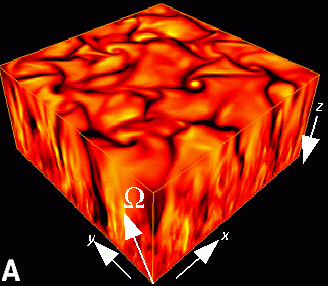
|
This image illustrates how computers can be used to study the convection zone of the Sun. More about that below.
It is rotating. A big difference between the boiling pot of water and the convection zone is that the Sun is rotating. This affects the motions of the blobs of plasma. Instead of rising and sinking vertically, they go up and down in a swirling way. This effect of the rotation on the motions is called the Coriolis force and is also present on the earth: look at the motion of the water when you empty the tub after taking a bath. Does it swirl always in the same direction?
Another important aspect of the solar rotation is that, unlike the Earth, the Sun does not rotate like a solid body. Observations of its surface have revealed that the equatorial regions rotate faster than the poles. If you were standing on the solar equator it would take you 26 days to go round the Sun, while if you where standing close to one of the solar poles it would take you about 32 days. This is called differential rotation.
A lot of what we know today about the way the Sun rotates and other global motions in its interior have been discovered thanks to the helioseismology.
It generates magnetic fields. The interaction of the convective turbulent motions of the gas in the convection zone and the differential rotation leads to the generation of electric currents and solar magnetic fields. This process is called the solar dynamo mechanism. On the earth we use dynamos to produce electricity and we call them electricity generators. You find them in a car, on a bike and also in a power station. The basic principle is always the same: out of a rotational motion electricity and magnetic field are created. Click here to learn more about that.
The magnetic field generated in the convection zone has important properties:
It tends to agglomerate into bundles of magnetic field or magnetic flux tubes
It is buoyant. This means that it is lighter than its surroundings. The consequence is that once it has been created it tends to rise toward the surface.
 It is
elastic like a rubber band. Thus, if you try to push sideway on
it (red arrows), its internal tension pushes back in the
opposite direction (blue arrow).
It is
elastic like a rubber band. Thus, if you try to push sideway on
it (red arrows), its internal tension pushes back in the
opposite direction (blue arrow).
 Magnetic field
lines have no ends: the magnetic field always close on itself.
Magnetic field
lines have no ends: the magnetic field always close on itself.
 If a magnetic field
line is deformed so much that in some place it makes an X, it can
reconnect. That is how magnetic field lines can split or merge.
If a magnetic field
line is deformed so much that in some place it makes an X, it can
reconnect. That is how magnetic field lines can split or merge.
Because the flows in the convection zone are turbulent, the magnetic field generated by the dynamo action in the Sun has a very complicated structure. This is an example of it, again taken from a numerical simulation (click on the image to see an animation of it):
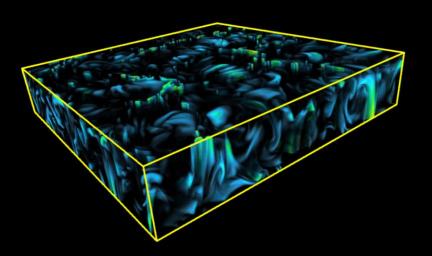
|
It transports magnetic fields. Once it has been created, the magnetic field is being moved and deformed by the convective flows. Eventually, a substantial amount of it is stored near the bottom of the convection zone in what is called the overshooting region. In this storage place, the magnetic field is aligned with the toroidal direction, a bit like a thin donuts.
How the magnetic field ends up stored in this manner is still a very mysterious problem. What we know is that the differential rotation plays an important role in this. Imagine you have a magnetic field line which is like a meridian (it is oriented north to South). Because the equator of the Sun rotates faster than the poles, it winds the field line around the Sun like it is illustrated in this picture:
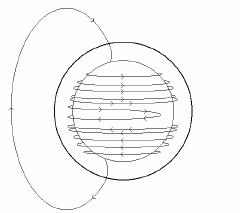
|
In this manner two thin donuts of magnetic fields are created around the Sun: one slightly above the equator and another one slightly below the equator. Question: apart from the effect of the differential rotation, is there any other reason to believe that the magnetic field is stored more or less in this form? Answer = another question: do the active regions (new group of sunspots) appear in some special locations on the solar surface? Answer.
If a substantial part of the magnetic field generated by the dynamo tends to be stored near the bottom of the convection zone, then we have to explain how the magnetic field escape from this storage place and rise up to the surface. The explanation found by the scientists is summarized in this computer generated picture:
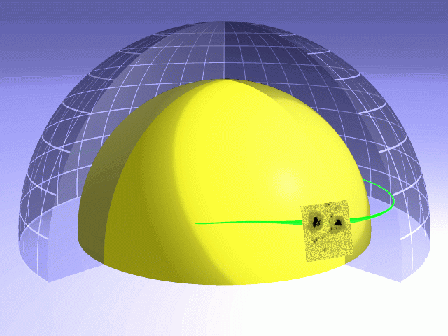
|
The yellow hemisphere represents the bottom of the convection zone and the transparent one represents its surface. The green line is a bundle of magnetic field lines which has risen from the bottom of the convection zone (where it was stored) up to the surface. The little superimposed picture with the two sunspots shows how the bundle of magnetic field lines appears to us when it emerges at the surface. This picture was generated with computers in an attempt to understand the mechanisms that govern the emergence of new magnetic regions on the surface of the Sun. It illustrates well how computers can be useful to study the interior of the Sun.
This plan seems to be very straightforward but there is a little problem. How do we make sure that the Sun in the computer is reasonably similar to the real one? In effect, if the virtual Sun has nothing to do with the reality, then studying this computer generated Sun does not tell us a lot about the real one. Speaking in terms of computer games, we want our virtual world to be like the one you find in a flight simulator, not like the one you find in a fantasy game: in a flight simulator if you make a bad maneuver your virtual plane may fall and crash; in a fantasy game, the hero may be able to do impossible things, like jumping higher than a 20 stores building. The main difference between the two games is that the flight simulator is based on the laws of physics, whereas the fantasy game is based on the imagination of its authors. So, we have to make sure that our virtual Sun is based only on the laws of physics and that it has nothing to do with fantasy. How do we do that?
When we construct our virtual Sun in the computer we do not want to include all the physical ingredients at once. First of all, because no computers is big enough and fast enough to tackle all the complication of the Sun at once. Secondly, because we want to discover which are the important physical processes which govern the dynamics in the interior of the convection zone, and which ingredients are secondary.
Imagine that we have observed the surface of the Sun and that we have noticed something intriguing that we would like to understand. To do this we proceed by trial and error in an organized way:
One problem for the study of which computers have been used extensively is the solar granulation. When we look at the surface with a telescope we see something like in the picture A in the image below.
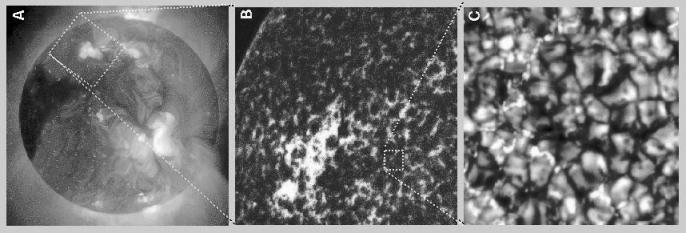
|
Zooming in, the surface of the Sun appears like in the picture C. This looks very much like the surface of a convecting liquid and. So, it suggests that convection could be the mechanism responsible for the motions in the this part of the Sun. In order to test this idea we can use the computer in the following manner.
First we built in the computer a convecting layer. We make a box in which we put a liquid which has properties similar to those of the solar plasma. We heat the box from below (we tell the computer that the bottom has a very high temperature) and we cool it at the top (we tell the computer that the surface temperature is much smaller than the bottom one). Then, we give to the computer the laws of physics that it will use. We tell the computer: given a blob of liquid, this how you calculate its speed, this is how you calculate its temperature, ... etc.
Once this is done, we tell the computer: go ahead and begin calculating how the liquid in the box is evolving. If we have made no error, after a little while the liquid in the virtual box begins to boil, or to convect.
The next step is to compare the surface of our virtual box with the image of the surface granulation on the Sun. What we see in our computer is this (click on the image to see an animation of the simulation).
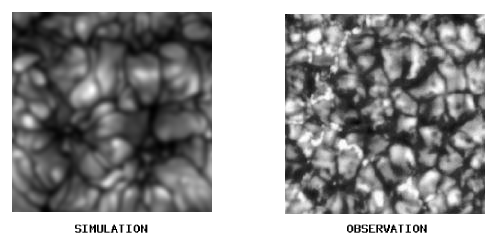
|
They look kind of similar. This is nice because it indicates that
we are on the right tracks. Now we can begin to ask some details about
convection and we can answer them by looking at our numerical
simulation. For example: what does determine the horizontal size
of the cells? How does the temperature look inside?, ....
LEARN MORE ABOUT SOME PARTICULAR TOPICS